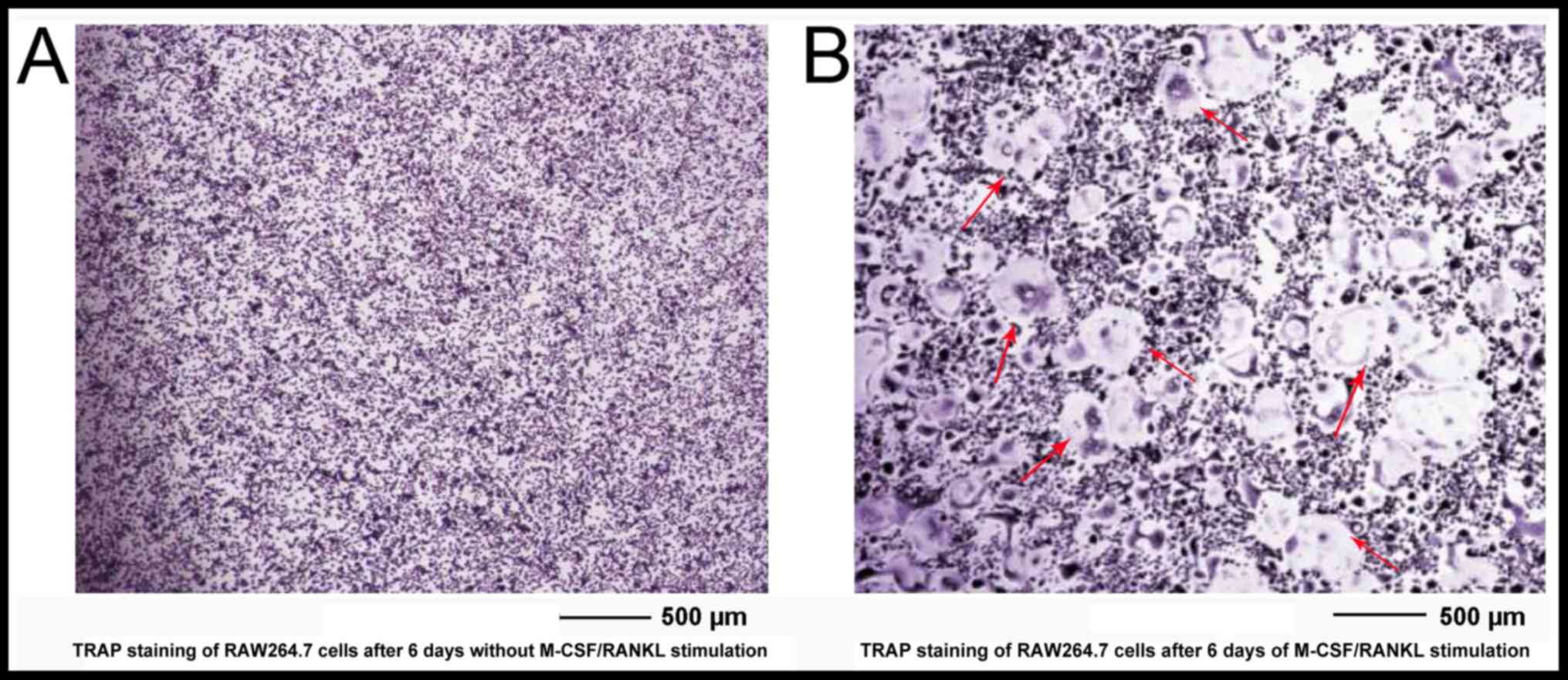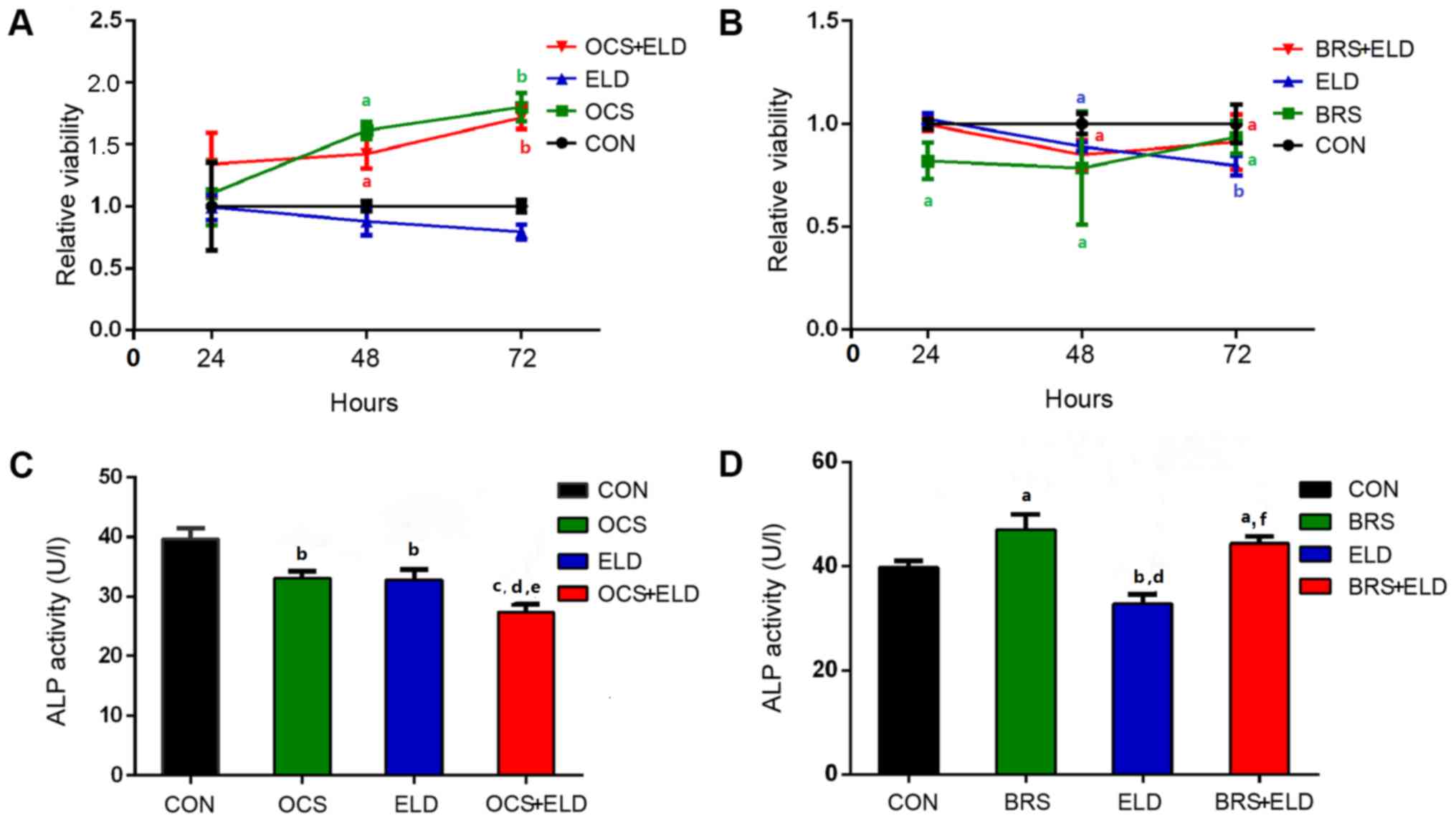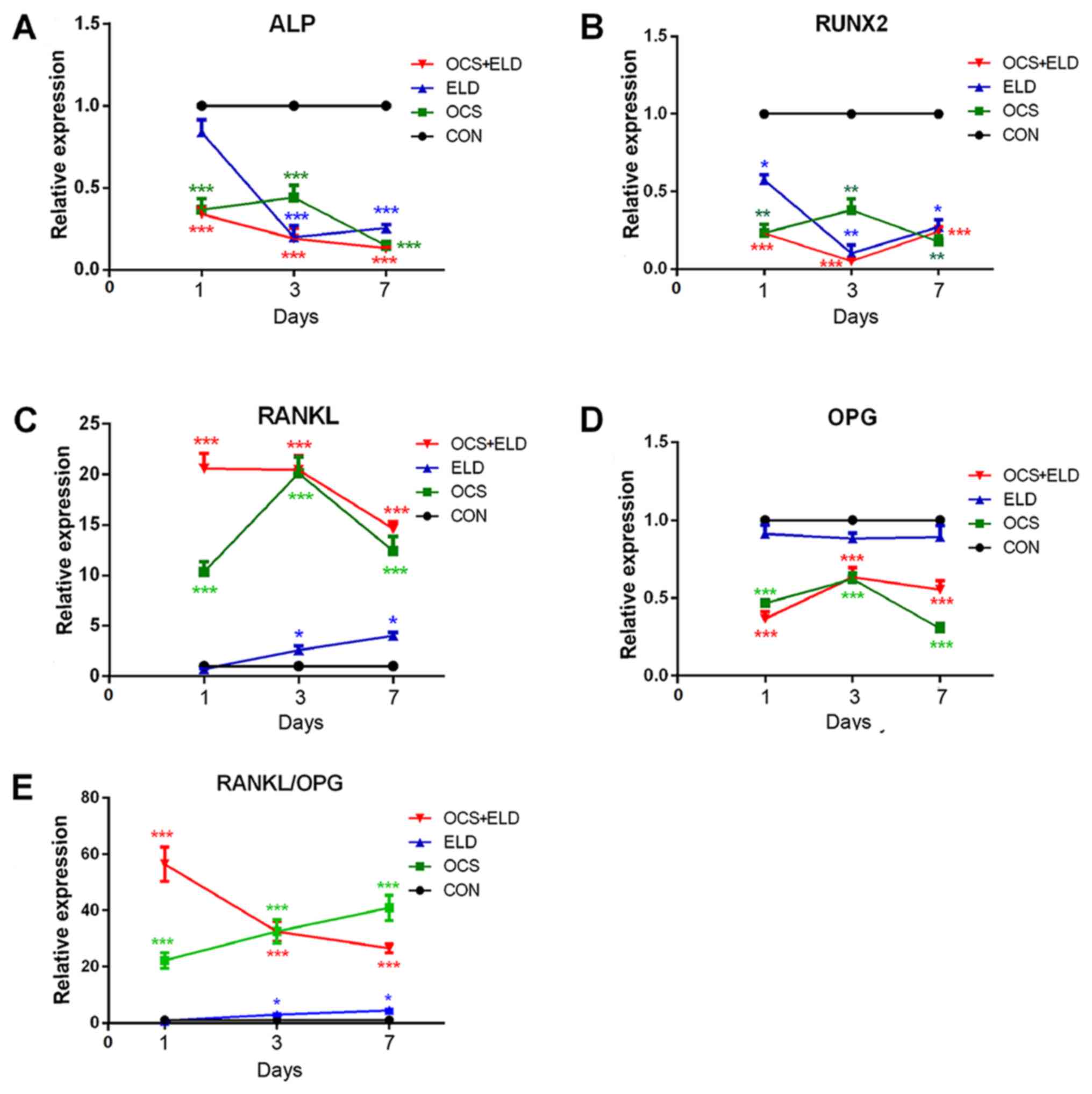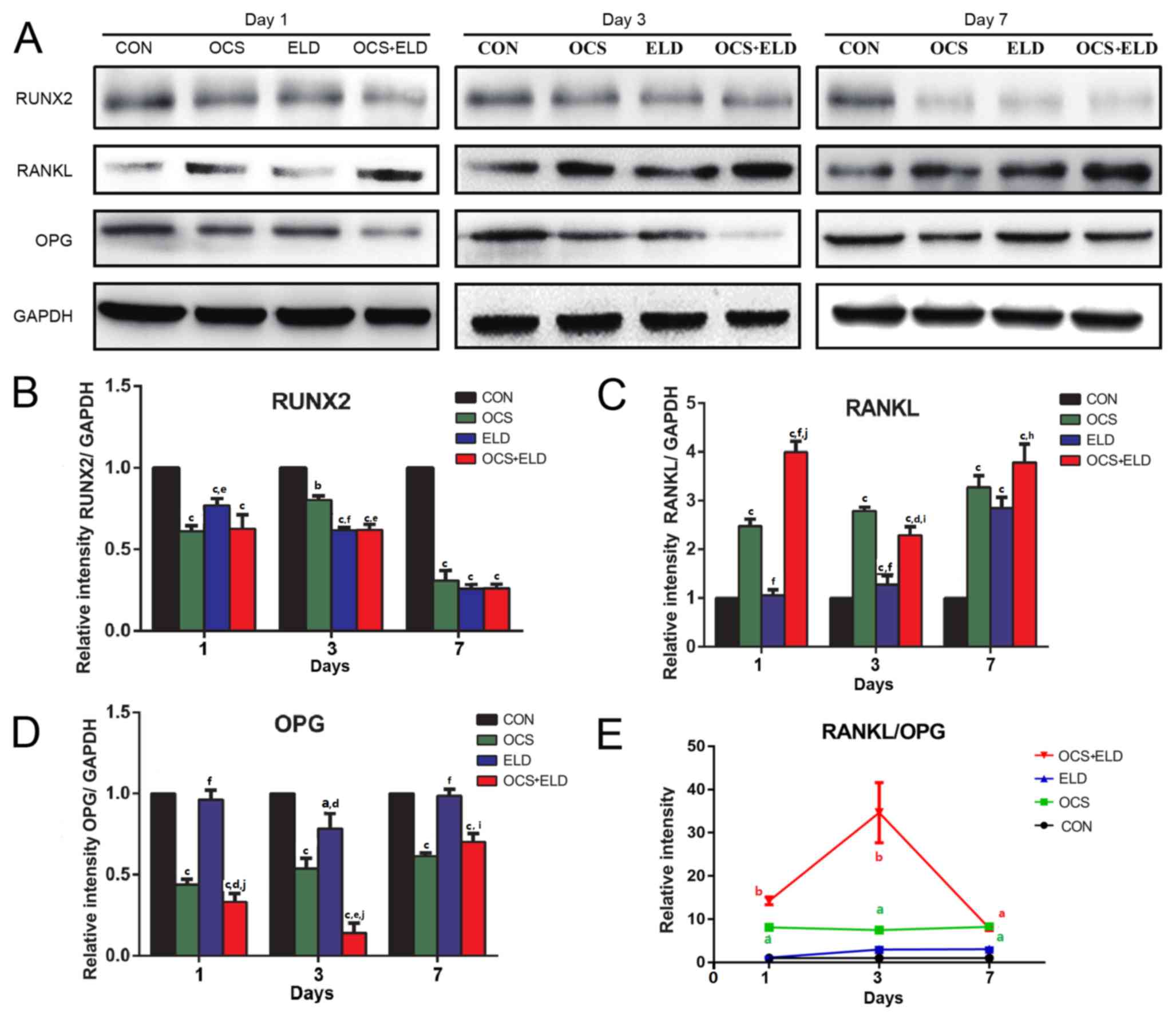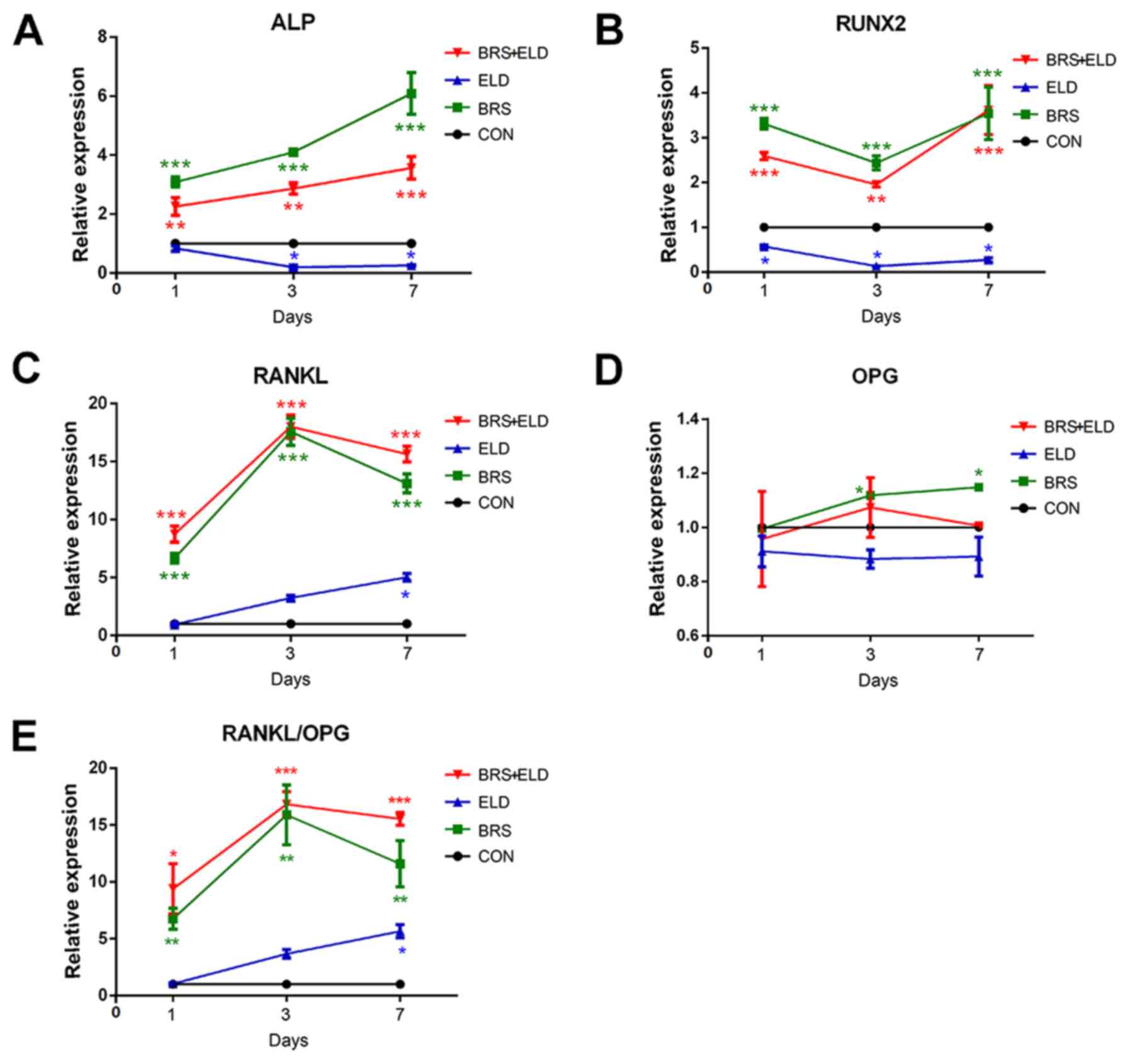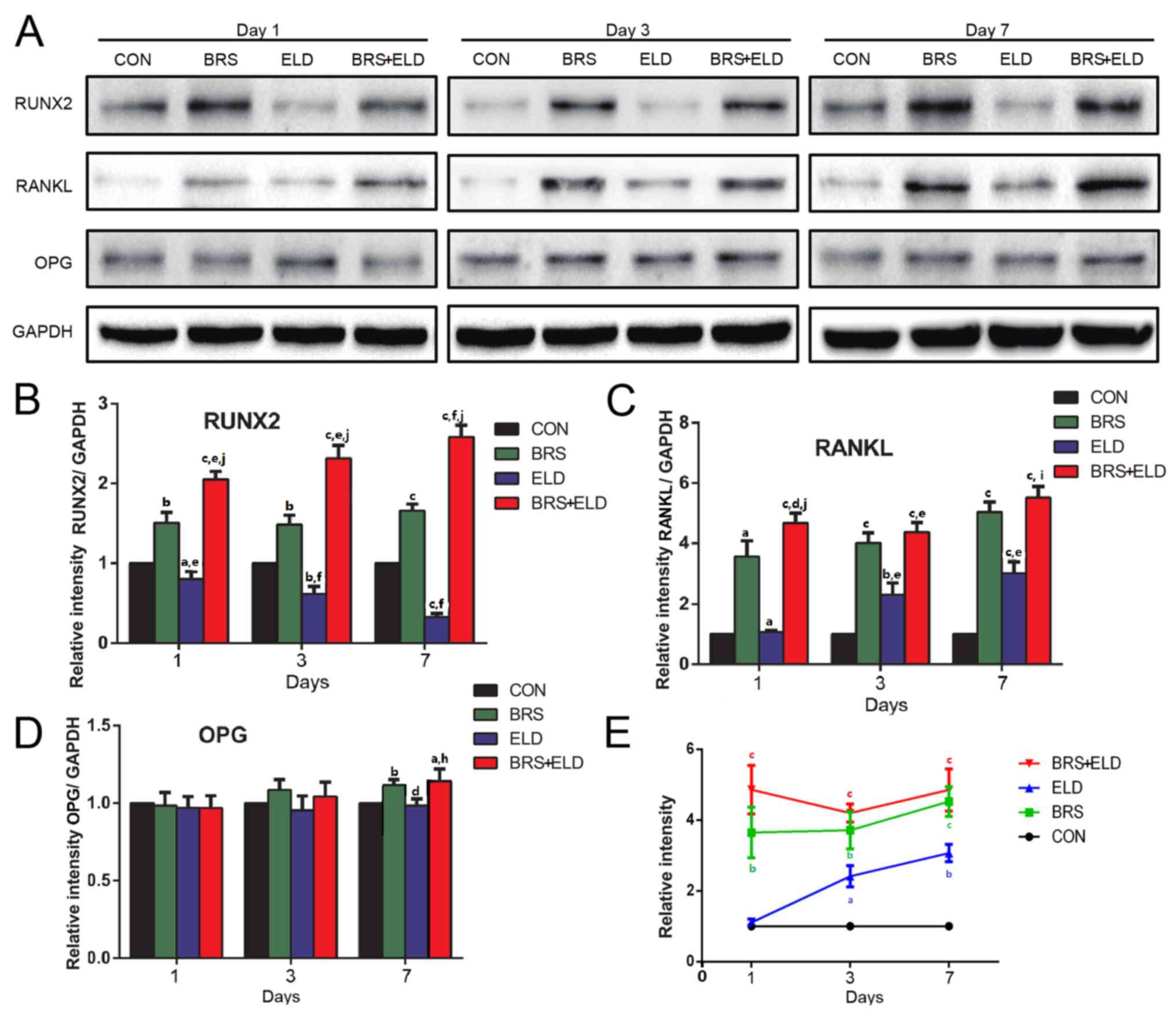|
1
|
Hadjidakis DJ and Androulakis II: Bone
remodeling. Ann N Y Acad Sci. 1092:385–396. 2006. View Article : Google Scholar : PubMed/NCBI
|
|
2
|
Matsuo K and Irie N: Osteoclast-osteoblast
communication. Arch Biochem Biophys. 473:201–209. 2008. View Article : Google Scholar : PubMed/NCBI
|
|
3
|
Tamma R and Zallone A: Osteoblast and
osteoclast crosstalks: From OAF to Ephrin. Inflamm Allergy Drug
Targets. 11:196–200. 2012. View Article : Google Scholar : PubMed/NCBI
|
|
4
|
Ueno Y, Shinki T, Nagai Y, Murayama H,
Fujii K and Suda T: In vivo administration of 1,25-dihydroxyvitamin
D3 suppresses the expression of RANKL mRNA in bone of
thyroparathyroidectomized rats constantly infused with PTH. J Cell
Biochem. 90:267–277. 2003. View Article : Google Scholar : PubMed/NCBI
|
|
5
|
van Driel M and van Leeuwen JP: Vitamin D
endocrine system and osteoblasts. Bonekey Rep. 3:4932014.
View Article : Google Scholar : PubMed/NCBI
|
|
6
|
Pèrez A, Chen TC, Turner A, Raab R, Bhawan
J, Poche P and Holick MF: Efficacy and safety of topical calcitriol
(1,25-dihydroxyvitamin d3) for the treatment of psoriasis. Br J
Dermatol. 134:238–246. 1996. View Article : Google Scholar : PubMed/NCBI
|
|
7
|
Guyton KZ, Kensler TW and Posner GH:
Cancer chemoprevention using natural vitamin D and synthetic
analogs. Annu Rev Pharmacol Toxicol. 41:421–442. 2001. View Article : Google Scholar : PubMed/NCBI
|
|
8
|
Nishii Y: Active vitamin D and its analogs
as drugs for the treatment of osteoporosis: Advantages and
problems. J Bone Miner Metab. 20:57–65. 2002. View Article : Google Scholar : PubMed/NCBI
|
|
9
|
Nishii Y and Okano T: History of the
development of new vitamin D analogs: Studies on 22-oxacalcitriol
(OCT) and 2beta- (3-hydroxypropoxy)calcitriol (ED-71). Steroids.
66:137–146. 2001. View Article : Google Scholar : PubMed/NCBI
|
|
10
|
Nishii Y: Rationale for active vitamin D
and analogs in the treatment of osteoporosis. J Cell Biochem.
88:381–386. 2003. View Article : Google Scholar : PubMed/NCBI
|
|
11
|
Mano H, Nishikawa M, Yasuda K, Ikushiro S,
Saito N, Takano M, Kittaka A and Sakaki T: Development of novel
bioluminescent sensor to detect and discriminate between vitamin D
receptor agonists and antagonists in living cells. Bioconjug Chem.
26:2038–2045. 2015. View Article : Google Scholar : PubMed/NCBI
|
|
12
|
Matsumoto T, Miki T, Hagino H, Sugimoto T,
Okamoto S, Hirota T, Tanigawara Y, Hayashi Y, Fukunaga M, Shiraki M
and Nakamura T: A new active vitamin D, ED-71, increases bone mass
in osteoporotic patients under vitamin D supplementation: A
randomized, double-blind, placebo-controlled clinical trial. J Clin
Endocrinol Metab. 90:5031–5036. 2005. View Article : Google Scholar : PubMed/NCBI
|
|
13
|
Matsumoto T, Takano T, Yamakido S,
Takahashi F and Tsuji N: Comparison of the effects of eldecalcitol
and alfacalcidol on bone and calcium metabolism. J Steroid Biochem
Mol Biol. 121:261–264. 2010. View Article : Google Scholar : PubMed/NCBI
|
|
14
|
Hatakeyama S, Yoshino M, Eto K, Takahashi
K, Ishihara J, Ono Y, Saito H and Kubodera N: Synthesis and
preliminary biological evaluation of 20-epi-eldecalcitol
[20-epi-1alpha,25- dihydroxy-2beta-(3-hydroxypropoxy)vitamin D3:
20-epi-ED-71]. J Steroid Biochem Mol Biol. 121:25–28. 2010.
View Article : Google Scholar : PubMed/NCBI
|
|
15
|
Uchiyama Y, Higuchi Y, Takeda S, Masaki T,
Shira-Ishi A, Sato K, Kubodera N, Ikeda K and Ogata E: ED-71, a
vitamin D analog, is a more potent inhibitor of bone resorption
than alfacalcidol in an estrogen-deficient rat model of
osteoporosis. Bone. 30:582–588. 2002. View Article : Google Scholar : PubMed/NCBI
|
|
16
|
Tang Y, Wu X, Lei W, Pang L, Wan C, Shi Z,
Zhao L, Nagy TR, Peng X, Hu J, et al: TGF-beta1-induced migration
of bone mesenchymal stem cells couples bone resorption with
formation. Nat Med. 15:757–765. 2009. View Article : Google Scholar : PubMed/NCBI
|
|
17
|
Weivoda MM, Ruan M, Pederson L, Hachfeld
C, Davey RA, Zajac JD, Westendorf JJ, Khosla S and Oursler MJ:
Osteoclast TGF-β receptor signaling induces Wnt1 secretion and
couples bone resorption to bone formation. J Bone Miner Res.
31:76–85. 2016. View Article : Google Scholar : PubMed/NCBI
|
|
18
|
Xian L, Wu X, Pang L, Lou M, Rosen CJ, Qiu
T, Crane J, Frassica F, Zhang L, Rodriguez JP, et al: Matrix IGF-1
maintains bone mass by activation of mTOR in mesenchymal stem
cells. Nat Med. 18:1095–1101. 2012. View Article : Google Scholar : PubMed/NCBI
|
|
19
|
Engelholm LH, Melander MC, Hald A, Persson
M, Madsen DH, Jürgensen HJ, Johansson K, Nielsen C, Nørregaard KS,
Ingvarsen SZ, et al: Targeting a novel bone degradation pathway in
primary bone cancer by inactivation of the collagen receptor
uPARAP/Endo180. J Pathol. 238:120–133. 2016. View Article : Google Scholar : PubMed/NCBI
|
|
20
|
Boeyens JC, Deepak V, Chua WH, Kruger MC,
Joubert AM and Coetzee M: Effects of ω3- and ω6-polyunsaturated
fatty acids on RANKL-induced osteoclast differentiation of RAW264.7
cells: A comparative in vitro study. Nutrients. 6:2584–2601. 2014.
View Article : Google Scholar : PubMed/NCBI
|
|
21
|
Lee YS, Kim YS, Lee SY, Kim GH, Kim BJ,
Lee SH, Lee KU, Kim GS, Kim SW and Koh JM: AMP kinase acts as a
negative regulator of RANKL in the differentiation of osteoclasts.
Bone. 47:926–937. 2010. View Article : Google Scholar : PubMed/NCBI
|
|
22
|
Choi SW, Son YJ, Yun JM and Kim SH:
Fisetin inhibits osteoclast differentiation via downregulation of
p38 and c-Fos-NFATc1 signaling pathways. Evid Based Complement
Alternat Med. 2012:8105632012. View Article : Google Scholar : PubMed/NCBI
|
|
23
|
Livak KJ and Schmittgen TD: Analysis of
relative gene expression data using real-time quantitative PCR and
the 2(-Delta Delta C(T)) method. Methods. 25:402–408. 2001.
View Article : Google Scholar : PubMed/NCBI
|
|
24
|
Zauli G, Rimondi E, Nicolin V, Melloni E,
Celeghini C and Secchiero P: TNF-related apoptosis-inducing ligand
(TRAIL) blocks osteoclastic differentiation induced by RANKL plus
M-CSF. Blood. 104:2044–2050. 2004. View Article : Google Scholar : PubMed/NCBI
|
|
25
|
Kim MH, Shim KS, Lee SU, Kim YS, Min YK
and Kim SH: Stimulatory effect of undecylenic acid on mouse
osteoblast differentiation. Phytother Res. 24:559–564.
2010.PubMed/NCBI
|
|
26
|
Kubota K, Sakikawa C, Katsumata M,
Nakamura T and Wakabayashi K: Platelet-derived growth factor BB
secreted from osteoclasts acts as an osteoblastogenesis inhibitory
factor. J Bone Miner Res. 17:257–265. 2010. View Article : Google Scholar
|
|
27
|
Tanaka Y, Nakayamada S and Okada Y:
Osteoblasts and osteoclasts in bone remodeling and inflammation.
Curr Drug Targets Inflamm Allergy. 4:325–328. 2005. View Article : Google Scholar : PubMed/NCBI
|
|
28
|
Nishiya Y and Sugimoto S: Effects of
various antihypertensive drugs on the function of osteoblast. Biol
Pharm Bull. 24:628–633. 2001. View Article : Google Scholar : PubMed/NCBI
|
|
29
|
Toray H, Hasegawa T, Sakagami N, Tsuchiya
E, Kudo A, Zhao S, Moritani Y, Abe M, Yoshida T, Yamamoto T, et al:
Histochemical assessment for osteoblastic activity coupled with
dysfunctional osteoclasts in c-src deficient mice. Biomed Res.
38:123–134. 2017. View Article : Google Scholar : PubMed/NCBI
|
|
30
|
Komori T: Regulation of bone development
and extracellular matrix protein genes by RUNX2. Cell Tissue Res.
339:189–195. 2010. View Article : Google Scholar : PubMed/NCBI
|
|
31
|
Hoemann CD, El-Gabalawy H and McKee MD: In
vitro osteogenesis assays: Influence of the primary cell source on
alkaline phosphatase activity and mineralization. Pathol Biol
(Paris). 57:318–323. 2009. View Article : Google Scholar : PubMed/NCBI
|
|
32
|
Han Y, You X, Xing W, Zhang Z and Zou W:
Paracrine and endocrine actions of bone-the functions of secretory
proteins from osteoblasts, osteocytes, and osteoclasts. Bone Res.
6:162018. View Article : Google Scholar : PubMed/NCBI
|
|
33
|
Kurihara N, Ishizuka S, Kiyoki M, Haketa
Y, Ikeda K and Kumegawa M: Effects of 1,25-dihydroxyvitamin D3 on
osteoblastic MC3T3-E1 cells. Endocrinology. 118:940–947. 1986.
View Article : Google Scholar : PubMed/NCBI
|
|
34
|
van den Bemd GJ, Pols HA, Birkenhäger JC,
Kleinekoort WM and van Leeuwen JP: Differential effects of
1,25-dihydroxyvitamin D3-analogs on osteoblast-like cells and on in
vitro bone resorption. J Steroid Biochem Mol Biol. 55:337–346.
1995. View Article : Google Scholar : PubMed/NCBI
|
|
35
|
Haneji T, Kurihara N, Ikeda K and Kumegawa
M: 1 alpha, 25-Dihydroxyvitamin D3 and analogues of vitamin D3
induce alkaline phosphatase activity in osteoblastic cells derived
from newborn mouse calvaria. J Biochem. 94:1127–1132. 1983.
View Article : Google Scholar : PubMed/NCBI
|
|
36
|
Majeska RJ and Rodan GA: The effect of
1,25(OH)2D3 on alkaline phosphatase in osteoblastic osteosarcoma
cells. J Biol Chem. 257:3362–3365. 1982.PubMed/NCBI
|
|
37
|
Jones G: Pharmacokinetics of vitamin D
toxicity. Am J Clin Nutr. 88:582S–586S. 2008. View Article : Google Scholar : PubMed/NCBI
|
|
38
|
Centrella M, McCarthy TL, Kusmik WF and
Canalis E: Relative binding and biochemical effects of
heterodimeric and homodimeric isoforms of platelet-derived growth
factor in osteoblast-enriched cultures from fetal rat bone. J Cell
Physiol. 147:420–426. 1991. View Article : Google Scholar : PubMed/NCBI
|
|
39
|
Yu X, Hsieh SC, Bao W and Graves DT:
Temporal expression of PDGF receptors and PDGF regulatory effects
on osteoblastic cells in mineralizing cultures. Am J Physiol.
272:C1709–C1716. 1997. View Article : Google Scholar : PubMed/NCBI
|
|
40
|
Ryu J, Kim HJ, Chang EJ, Huang H, Banno Y
and Kim HH: Sphingosine 1-phosphate as a regulator of osteoclast
differentiation and osteoclast-osteoblast coupling. EMBO J.
25:5840–5851. 2006. View Article : Google Scholar : PubMed/NCBI
|
|
41
|
Chen LL, Wang K, Zhang J and Wu YM: Effect
of the bone resorption supernatant from RAW264.7 osteoclast on the
osteogenic activity of mouse MC3T3-E1 cell. Zhonghua Kou Qiang Yi
Xue Za Zhi. 47:32–37. 2012.(In Chinese). PubMed/NCBI
|
|
42
|
Howard GA, Bottemiller BL, Turner RT,
Rader JI and Baylink DJ: Parathyroid hormone stimulates bone
formation and resorption in organ culture: Evidence for a coupling
mechanism. Proc Natl Acad Sci USA. 78:3204–3208. 1981. View Article : Google Scholar : PubMed/NCBI
|
|
43
|
Martin TJ and Sims NA: Osteoclast-derived
activity in the coupling of bone formation to resorption. Trends
Mol Med. 11:76–81. 2005. View Article : Google Scholar : PubMed/NCBI
|
|
44
|
Karsdal MA, Martin TJ, Bollerslev J,
Christiansen C and Henriksen K: Are nonresorbing osteoclasts
sources of bone anabolic activity? J Bone Miner Res. 22:487–494.
2007. View Article : Google Scholar : PubMed/NCBI
|
|
45
|
Sakagami N, Amizuka N, Li M, Takeuchi K,
Hoshino M, Nakamura M, Nozawa-Inoue K, Udagawa N and Maeda T:
Reduced osteoblastic population and defective mineralization in
osteopetrotic (op/op) mice. Micron. 36:688–695. 2005. View Article : Google Scholar : PubMed/NCBI
|
|
46
|
Grigoriadis AE, Wang ZQ, Cecchini MG,
Hofstetter W, Felix R, Fleisch HA and Wagner EF: c-Fos: A key
regulator of osteoclast-macrophage lineage determination and bone
remodeling. Science. 266:443–448. 1994. View Article : Google Scholar : PubMed/NCBI
|
|
47
|
Soriano P, Montgomery C, Geske R and
Bradley A: Targeted disruption of the c-src proto-oncogene leads to
osteopetrosis in mice. Cell. 64:693–702. 1991. View Article : Google Scholar : PubMed/NCBI
|
|
48
|
Gray C, Boyde A and Jones SJ:
Topographically induced bone formation in vitro: Implications for
bone implants and bone grafts. Bone. 18:115–123. 1996. View Article : Google Scholar : PubMed/NCBI
|
|
49
|
Kalu DN, Doyle FH, Pennock J,
Denys-Matrajt H and Foster GV: Anabolic effect of parathyroid
hormone on bone in the rat. Calcif Tissue Res. (Suppl):S721970.
View Article : Google Scholar
|
|
50
|
Baldock PA, Thomas GP, Hodge JM, Baker SU,
Dressel U, O'Loughlin PD, Nicholson GC, Briffa KH, Eisman JA and
Gardiner EM: Vitamin D action and regulation of bone remodeling:
Suppression of osteoclastogenesis by the mature osteoblast. J Bone
Miner Res. 21:1618–1626. 2006. View Article : Google Scholar : PubMed/NCBI
|
|
51
|
Schwarz P, Brixen KT and Mosekilde L:
Calcium homeostasis and normal bone remodeling. Ugeskr Laeger.
167:871–873. 2005.(In Danish). PubMed/NCBI
|
|
52
|
Sanchez-Fernandez MA, Gallois A, Riedl T,
Jurdic P and Hoflack B: Osteoclasts control osteoblast chemotaxis
via PDGF-BB/PDGF receptor beta signaling. PLoS One. 3:e35372008.
View Article : Google Scholar : PubMed/NCBI
|
|
53
|
Lotinun S, Kiviranta R, Matsubara T,
Alzate JA, Neff L, Lüth A, Koskivirta I, Kleuser B, Vacher J,
Vuorio E, et al: Osteoclast-specific cathepsin K deletion
stimulates S1P-dependent bone formation. J Clin Invest.
123:666–681. 2013.PubMed/NCBI
|
|
54
|
Noguchi Y, Kawate H, Nomura M and
Takayanagi R: Eldecalcitol for the treatment of osteoporosis. Clin
Interv Aging. 8:1313–1321. 2013.PubMed/NCBI
|
|
55
|
Suda T, Takahashi F and Takahashi N: Bone
effects of vitamin D-Discrepancies between in vivo and in vitro
studies. Arch Biochem Biophys. 523:22–29. 2012. View Article : Google Scholar : PubMed/NCBI
|
|
56
|
Shi YC, Worton L, Esteban L, Baldock P,
Fong C, Eisman JA and Gardiner EM: Effects of continuous activation
of vitamin D and Wnt response pathways on osteoblastic
proliferation and differentiation. Bone. 41:87–96. 2007. View Article : Google Scholar : PubMed/NCBI
|
|
57
|
Chen YC, Ninomiya T, Hosoya A, Hiraga T,
Miyazawa H and Nakamura H: 1α,25-Dihydroxyvitamin D3 inhibits
osteoblastic differentiation of mouse periodontal fibroblasts. Arch
Oral Biol. 57:453–459. 2012. View Article : Google Scholar : PubMed/NCBI
|
|
58
|
Tanaka H and Seino Y: Direct action of
1,25-dihydroxyvitamin D on bone: VDRKO bone shows excessive bone
formation in normal mineral condition. J Steroid Biochem Mol Biol.
89:343–345. 2004. View Article : Google Scholar : PubMed/NCBI
|
|
59
|
Yamamoto Y, Yoshizawa T, Fukuda T,
Shirode-Fukuda Y, Yu T, Sekine K, Sato T, Kawano H, Aihara K,
Nakamichi Y, et al: Vitamin D receptor in osteoblasts is a negative
regulator of bone mass control. Endocrinology. 154:1008–1020. 2013.
View Article : Google Scholar : PubMed/NCBI
|
|
60
|
Nakamichi Y, Udagawa N, Horibe K,
Mizoguchi T, Yamamoto Y, Nakamura T, Hosoya A, Kato S, Suda T and
Takahashi N: VDR in osteoblast-lineage cells primarily mediates
vitamin D treatment-induced increase in bone mass by suppressing
bone resorption. J Bone Miner Res. 32:1297–1308. 2017. View Article : Google Scholar : PubMed/NCBI
|
|
61
|
Amling M, Priemel M, Holzmann T, Chapin K,
Rueger JM, Baron R and Demay MB: Rescue of the skeletal phenotype
of vitamin D receptor-ablated mice in the setting of normal mineral
ion homeostasis: Formal histomorphometric and biomechanical
analyses. Endocrinology. 140:4982–4987. 1999. View Article : Google Scholar : PubMed/NCBI
|
|
62
|
Lieben L and Carmeliet G: The delicate
balance between vitamin D, calcium and bone homeostasis: Lessons
learned from intestinal- and osteocyte-specific VDR null mice. J
Steroid Biochem Mol Biol. 136:102–106. 2013. View Article : Google Scholar : PubMed/NCBI
|
|
63
|
Lee SK, Kalinowski J, Jastrzebski S and
Lorenzo JA: 1,25(OH)2 vitamin D3-stimulated osteoclast formation in
spleen-osteoblast cocultures is mediated in part by enhanced IL-1
alpha and receptor activator of NF-kappa B ligand production in
osteoblasts. J Immunol. 169:2374–2380. 2002. View Article : Google Scholar : PubMed/NCBI
|















